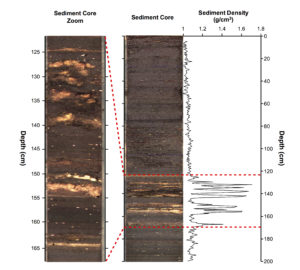
UNIVERSITY OF CAMBRIDGE—The severity of drought conditions during the demise of the Maya civilization about one thousand years ago has been quantified, representing another piece of evidence that could be used to solve the longstanding mystery of what caused the downfall of one of the ancient world’s great civilizations.
Researchers from the University of Cambridge and the University of Florida developed a method to measure the different isotopes of water trapped in gypsum, a mineral that forms during times of drought when the water level is lowered, in Lake Chichancanab in Mexico’s Yucatán Peninsula where the Maya were based.
Based on these measurements, the researchers found that annual precipitation decreased between 41% and 54% during the period of the Maya civilization’s collapse, with periods of up to 70% rainfall reduction during peak drought conditions, and that relative humidity declined by 2% to 7% compared to today. The results are reported in the journal Science.
“The role of climate change in the collapse of Classic Maya civilization is somewhat controversial, partly because previous records are limited to qualitative reconstructions, for example whether conditions were wetter or drier,” said Nick Evans, a PhD student in Cambridge’s Department of Earth Sciences and the paper’s first author. “Our study represents a substantial advance as it provides statistically robust estimates of rainfall and humidity levels during the Maya downfall.”
Maya civilization is divided into four main periods: the Preclassic (2000 BCE – 250 CE), Classic (250 CE – 800 CE), terminal Classic (800 – 1000 CE) and Postclassic (1000 CE – 1539 CE). The Classic period was marked by the construction of monumental architecture, intellectual and artistic development, and the growth of large city-states.
During the 9th century however, there was a major political collapse in the central Maya region: their famous limestone cities were abandoned and dynasties ended. And while the Maya people survived beyond this period, their political and economic power was depleted.
There are multiple theories as to what caused the collapse of the Maya civilization, such as invasion, war, environmental degradation and collapsing trade routes. In the 1990s, however, researchers were able to piece together climate records for the period of the Maya collapse, and found that it correlated with an extended period of extreme drought.
Professor David Hodell, Director of Cambridge’s Godwin Laboratory for Palaeoclimate Research and the senior author of the current paper, provided the first physical evidence of a correlation between this period of drought at Lake Chichancanab and the downfall of the Classic Maya civilization in a paper published in 1995.
Now, Hodell and his colleagues have applied a new method and estimated the extent of this drought. Using a new geochemical method to measure the water locked within gypsum from Chichancanab, the researchers have built a complete model of hydrological conditions during the terminal Classic Period when the Maya collapsed.
The researchers analyzed the different isotopes of water trapped within the crystal structure of the gypsum to determine changes in rainfall and relative humidity during the Maya downfall.
They measured three oxygen and two hydrogen isotopes to reconstruct the history of the lake water between 800 and 1000 CE. When gypsum forms, water molecules are incorporated directly into its crystalline structure, and this water records the different isotopes that were present in the ancient lake water at the time of its formation. “This method is highly accurate and is almost like measuring the water itself,” said Evans.
In periods of drought, more water evaporates from lakes such as Chichancanab, and because the lighter isotopes of water evaporate faster, the water becomes heavier. A higher proportion of the heavier isotopes, such as oxygen-18 and hydrogen-2 (deuterium), would therefore indicate drought conditions. By mapping the proportion of the different isotopes contained within each layer of gypsum, the researchers were able to build a model to estimate past changes in rainfall and relative humidity over the period of the Maya collapse.
This quantitative climate data can be used to better predict how these drought conditions may have affected agriculture, including yields of the Maya’s staple crops, such as maize.
_________________________________

Edzná ruins, Campeche. Pictured is the 31 m tall Pirámide de los Cinco Pisos (pyramid of the five storeys), located in the Great Plaza. Sarah Collins, Cambridge University
__________________________

Mask of the Maya rain God ͚Chaac͛ on a building at Labná in the Puuc region of the northern Yucatán Peninsula. The prevalence of Chaac masks in the architecture throughout the Maya region is a testament to the importance of rainfall to the Maya. Mark Brenner
_________________________________

Image of the sediment core used in this study shown versus depth below the bottom of the lake. The sediment layers consist of dark layers that are composed of organic-rich deposits, and light-colored layers that are composed of the mineral gypsum (calcium sulfate dihydrate; CaSO4·2H2O). Gypsum forms when the lake level was lowered during times of drought. The hydration water in gypsum was used in this study to reconstruct the changes in rainfall of the region. The panel on the right displays the sediment density record of the core. Periods of gypsum precipitation are indicated by density values of >1.1 g/cm3. The interval from 165 to 125 cm spans the time from ~620 to ~1100 CE. The gypsum layers between 154 and 125 cm correspond approximately to the time of the decline of Classic Maya civilization. Credit: after Hodell et al. (2005)
Article Source: University of Cambridge news release
_________________________



